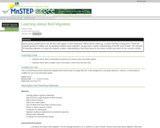
In this video segment from WILD TV, an ornithologist describes his job. [1:17]
- Subject:
- Science
- Material Type:
- Audio/Video
- Lesson
- Provider:
- PBS LearningMedia
- Date Added:
- 12/01/2022

In this video segment from WILD TV, an ornithologist describes his job. [1:17]

This article provides an overview of scientific inquiry and how citizen science programs run by the Cornell Lab of Ornithology provide opportunities for inquiry about birds.

Colorful pictures display birds of all kinds. You can hear the correct Spanish pronunciation and see the correct spelling by dragging your mouse over the picture.

This activity is a classroom introduction to bird migration. Students will acquire new vocabulary, sharpen their map skills, and discover the scientific reasons some birds migrate.

Get the facts about the Loggerhead Shrike. While only about the size of a robin, don?t underestimate this diminutive bird. The Loggerhead Shrike is a shrewd hunter and has been known to impale its prey on thorns or barbwire. Besides finding a detailed physical description, you?ll also learn about some of this bird's unique facts and characteristics. Also included in this Bird Fact Sheet on the Loggerhead Shrike is information on its habitat and habits, range, feeding, breeding, and conservation efforts. A list of resources completes the fact sheet.

Use this activity as an introduction to adaptations. Students will view video clips of birds and formulate their own observations and explanations for the different types of bird beaks and how they are used.

Get the facts about the Marbled Murrelet. Besides finding a detailed physical description, you?ll also learn about some of this bird's unique facts and characteristics. Also included in this Bird Fact Sheet on the Marbled Murrelet is information on its habitat and habits, range, feeding, breeding, and conservation efforts. Don?t forget to check out the sound clips of this interesting bird using the links near the top of the webpage. A list of resources completes the fact sheet.

This site from the National Zoological Park provides extensive information about many types of animals. Just click on the category you need. Includes pictures and live web cams.

Mister Chris wonders what it would feel like to fly. You're invited to think about different birds and the ways they take to the sky. Families, teachers, and children learn about how different types of birds have different features, feathers, and habitats that support different kinds of movements and help them survive in nature. Included is an additional activity on the diversity of birds. [9:43]

Use this Field Guide to Birds from the PBS Kids series Molly of Denali to identify and learn more about birds in your neighborhood. Then seek out additional information and create your own pages to add to Molly's guide.

PBS offers a look into the brains of birds. Examine each part of the brain and its function. Click an drag the brain to see a 3-D view.

In 2002, paleontologists discovered a fossil in China that seemed to provide a missing link between dinosaurs and birds, and to support the theory that birds evolved from dinosaurs. The fossil came from a four-winged dinosaur they named the Microraptor. This PBS video looks at the discovery and the debates and research that followed from it.

Students will learn to identify 3 to 4 birds by their song.

Is your state bird migrating farther north to escape the effects of global warming? This comprehensive resource answers this question by state.

Great site providing a "Quickindex" to find various resources. Also included are links to more information on this museum.

In this video from WOSU Columbus, learn about the types of communities of plants, animals, birds and fish that abound in wetlands. [1:25]

At least fifty different types of birds in Canada nest in cavities. This being said, these birds can adapt to nesting in nest boxes, which is a good thing since many of these birds? natural nesting sites are diminishing. Learn how to make and maintain a bird nesting box. A list of resources completes the discussion.

Get the facts about the Northern Gannet. Besides finding a detailed physical description of this spectacular diving sea bird, you?ll also learn about some its unique facts and characteristics. Also included in this Bird Fact Sheet on the Northern Gannet is information on its habitat and habits, range, feeding, breeding, and conservation efforts. Don?t forget to check out the video and sound clips of this interesting bird using the links near the top of the webpage. A list of resources completes the fact sheet.

Site allows users to tour the Oakland Zoo and view all types of animals from A-Z. Offers links to cool stuff and a world safari.